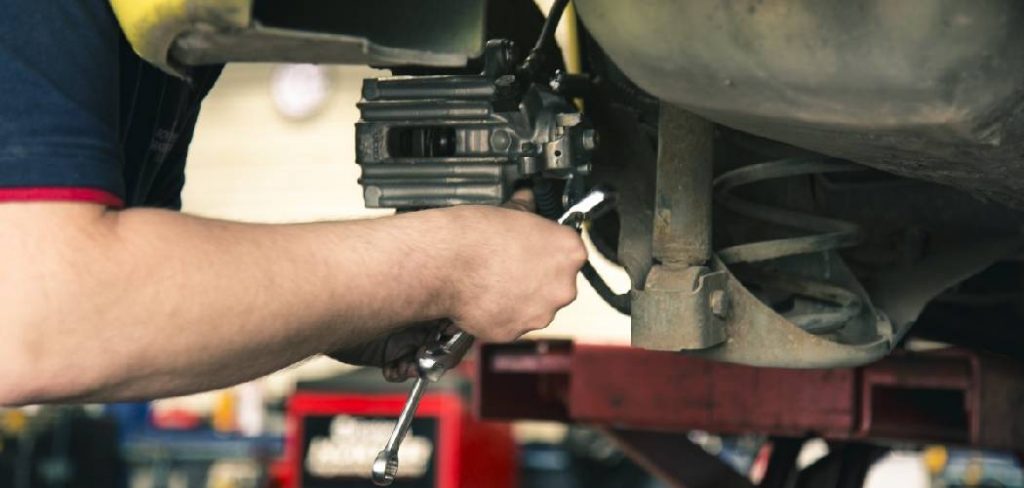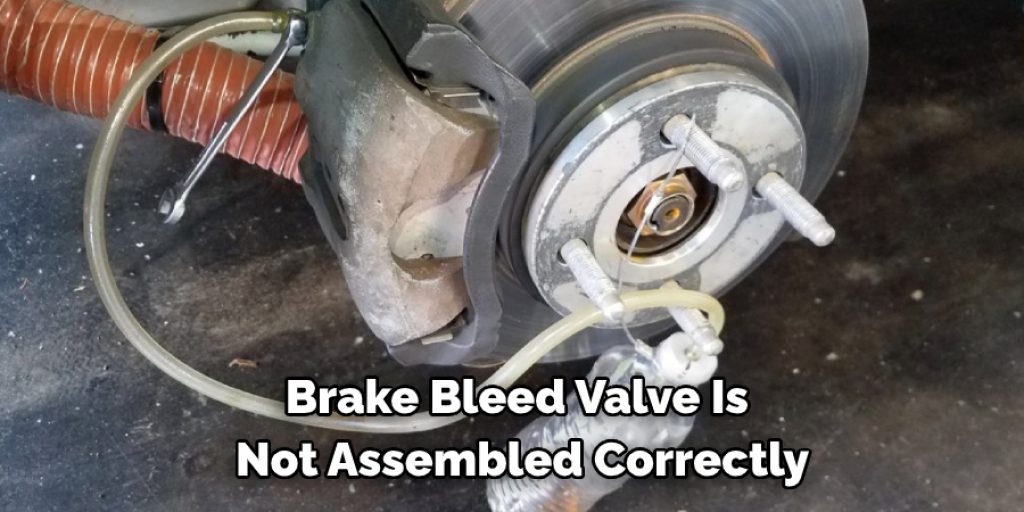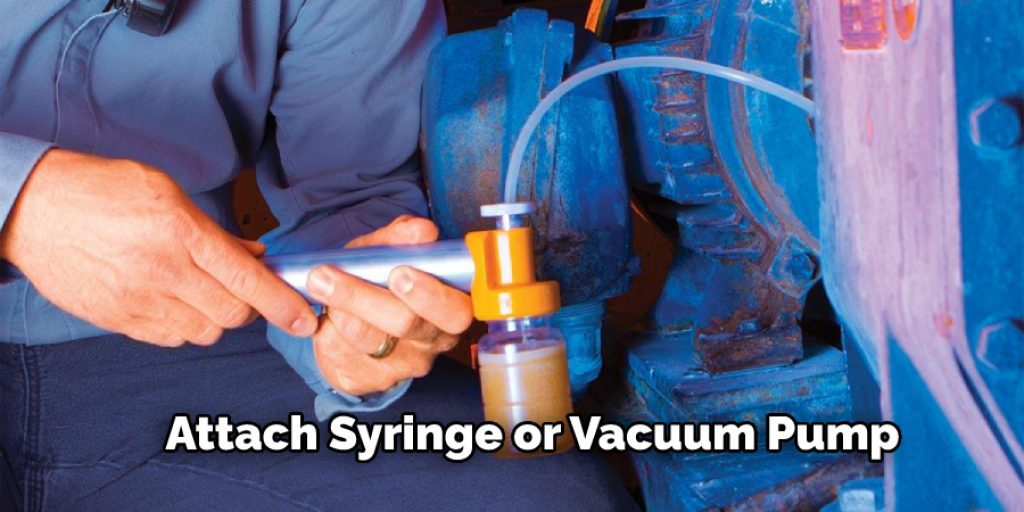If you’ve ever had to work on your vehicle’s braking system, you’re probably familiar with the brake bleed valve. This little device ensures that your brakes are functioning properly by releasing any air that might have gotten trapped in the system.
However, if your brake bleed valve starts leaking, it can be a major headache to fix. In this article, we’ll show you how to identify and how to fix a leaking brake bleed valve. We will also walk you through the process of bleeding your brakes, so you can keep your car safe on the road. Let’s get started!

Summary: Fixing a leaking brake bleed valve is relatively simple and straightforward. To begin, locate the brake bleed valve and remove any dirt or debris that may have collected around it. Remove the bleeder plug and inspect it for wear and tear.
Once secured, pour clean brake fluid into the reservoir and bleed out the old fluid by pumping the brake pedal until no more air bubbles appear in the line. Finally, put a layer of new gasket material on both sides of the valve and reinstall it onto your vehicle.
8 Common Reasons That Causes Leaking Brake Bleed Valve
1. Defective Gasket or Seal
A defective gasket or seal is often the cause of a leaking brake bleed valve. The gasket or seal can become brittle and crack over time, or dislodged from the brake bleed valve.
2. Damaged Brake Line
If the brake line is damaged, it may cause the brake bleed valve to leak. This could happen if the brake line was damaged during installation or if the car was in an accident. If the brake line is damaged, it will need to be replaced.
3. Faulty Brake Bleed Valve
The brake bleed valve might leak because there’s something wrong with the valve. If the valve isn’t working right, fluid will leak out and the brakes won’t work as well. If you think your brake bleed valve is broken, you should take it to a mechanic to get it fixed or replaced.
4. Improper Brake Bleeding
The brake bleed valve is responsible for making sure brake fluid doesn’t leak. If it’s not working properly, fluid will leak out and make the brakes less effective. If you think your brake bleed valve is broken, you should take it to a mechanic to get it fixed.
5. Damaged O-Ring
The o-ring is a seal that helps to prevent leaks. If the o-ring is damaged, it can cause the brake bleed valve to leak. You can replace the o-ring yourself or take the brake bleed valve to a mechanic to have it replaced.
6. Improper Assembly
If the brake bleed valve is not assembled correctly, it can also cause a leak. Ensure that all of the screws are correctly tightened and that the gasket is in place. If there is any damage to the gasket, replace it immediately.

7. Improperly Tightened Fitting:
If the valve is not tightened correctly, it can loosen over time and start to leak. This can be fixed by checking the fitting to make sure it is tight, and if it is not, tightening it using a wrench.
8. Damaged Brake Line
If the brake line is damaged, it can cause the valve to leak. The brake line may have been damaged during installation, or it may have been damaged when the car was in an accident. If the brake line is damaged, it will need to be replaced.
16 Easy Ways on How to Fix a Leaking Brake Bleed Valve
1.Assess the Situation:
Before attempting any repairs, evaluate the extent of the leak at the brake bleed valve. Determine if the leak is due to a damaged or worn valve, a loose connection, or debris in the valve. Identifying the root cause will help you choose the most effective solution.
2.Gather Necessary Tools and Materials:
To fix a leaking brake bleed valve, you will need the following tools and materials:
- Wrench or socket set
- Brake fluid
- Brake cleaner
- Shop rags or paper towels
- New brake bleed valve (if necessary)
- Teflon tape or thread sealant
- Safety goggles and gloves
3.Put on Safety Gear:
Before beginning any repair work, ensure you’re wearing appropriate safety gear, including safety goggles and gloves. This will protect your eyes and hands from potential injury while working with brake fluid and other components.
4.Locate the Brake Bleed Valve:
Find the brake bleed valve on the brake caliper. The valve is typically located near the top of the caliper and features a small nipple for attaching a hose during the bleeding process. Consult your vehicle’s manual for specific information on locating the bleed valve.
5.Clean the Area Around the Valve:
Using brake cleaner and a shop rag or paper towel, clean the area around the brake bleed valve to remove any dirt, grease, or debris. This will help you identify the source of the leak and prevent contaminants from entering the brake system during the repair process.
6.Tighten the Valve:
If the brake bleed valve is loose, use a wrench or socket to gently tighten it. Be careful not to overtighten the valve, as this can cause damage to the valve or caliper threads. If the leak persists after tightening, proceed to the next step.
7.Remove the Brake Bleed Valve:
Using a wrench or socket, carefully remove the brake bleed valve from the caliper. Be prepared for brake fluid to leak out once the valve is removed, and have a shop rag or paper towel on hand to catch any fluid.
8.Inspect the Valve for Damage:
Examine the removed brake bleed valve for signs of damage, such as worn or damaged threads, cracks, or debris lodged in the valve. If any damage is found, replace the valve with a new one.
9.Apply Teflon Tape or Thread Sealant:
If the brake bleed valve is in good condition, apply a small amount of Teflon tape or thread sealant to the valve’s threads. This will help create a better seal between the valve and caliper, preventing leaks.
10.Reinstall the Brake Bleed Valve:
Thread the brake bleed valve back into the caliper, ensuring a snug fit without overtightening. Use a wrench or socket to gently tighten the valve, being cautious not to damage the threads.
11.Clean the Area and Check for Leaks:
After reinstalling the brake bleed valve, use brake cleaner and a shop rag or paper towel to clean the area once more. Start the vehicle and press the brake pedal several times to build pressure in the system. Check the brake bleed valve for any signs of leaks. If no leaks are present, proceed to the next step.
12.Top Off Brake Fluid:
Check the brake fluid reservoir and top off the fluid as necessary. Be sure to use the appropriate type of brake fluid for your vehicle, as specified in the owner’s manual.
13.Bleed the Brake System:
To ensure proper brake function and remove any air that may have entered the system during the repair process, bleed the brake system according to your vehicle’s manual. This typically involves attaching a hose to the brake bleed valve, opening the valve, and pressing the brake pedal to force air and old fluid out of the system. Repeat this process for each wheel, following the recommended bleeding sequence for your vehicle.
14.Test the Brakes:
Once the brake system has been bled, start the vehicle and press the brake pedal several times to build pressure in the system. Ensure the pedal feels firm and responsive, indicating that there is no air in the brake lines.
15.Perform a Road Test:
Take the vehicle for a short drive to test the brakes under real-world conditions. Apply the brakes at various speeds and intensities to ensure they are functioning correctly and that there are no further leaks at the brake bleed valve.
16.Monitor for Future Leaks:
Keep an eye on the brake bleed valve for any signs of future leaks. Address any leaks promptly to prevent potential brake failure and maintain the safety of your vehicle.
By following these steps, you can effectively fix a leaking brake bleed valve and ensure the proper function of your vehicle’s braking system. The repair process requires attention to detail and the correct tools and materials, but with patience and care, a well-executed repair will provide a durable and lasting solution. Proper maintenance of your brake system, including regular fluid checks and periodic bleeding, will help to prevent future leaks and ensure the safety and performance of your vehicle.
You Can Check It Out To Fix a Bent Fender
Some Helpful Tips and Suggestions:
Here we have given some tips and suggestions on how to fix a leaking brake bleed valve
- If your brake bleed valve is leaking, you can fix it by using a little bit of Teflon tape around the threads.
- If the leak persists, you may need to replace the valve altogether.
- Always make sure that the brake system is completely drained of fluid before working on it.
- Be very careful when tightening the bleed valve, as overtightening it can strip the threads and create a more serious leak.
- If you’re not comfortable performing this repair yourself, take your vehicle to a qualified mechanic.
- Always use caution when working with brake fluid, as it is corrosive and can cause serious injury.
- Make sure to dispose of any old brake fluid properly according to local regulations.
- Always wear safety glasses and gloves when working on your brakes.
How Do You Bleed Brakes With a Broken Bleeder Valve?
If your brake bleed valve is broken, you can still bleed the brakes. You will need to use a syringe or other vacuum pump to create a vacuum and pull the fluid from the brake lines. Be sure to have an assistant help you, as it can be difficult to do this independently. Start by removing the brake bleed valve from the brake line.
Then, attach the syringe or vacuum pump to the brake bleed valve and create a vacuum. The assistant will open the brake caliper and allow fluid to flow into the syringe or vacuum pump. Keep the vacuum applied until all of the fluid has been removed from the brake line. Then, reattach the brake bleed valve to the brake line and close the caliper. Test the brakes to make sure they are working properly.

Frequently Asked Questions
Why is My Brake Bleeder Valve Leaking?
There are a few potential causes for brake bleeder valves to leak, including worn or damaged seals, inadequate lubrication, and defective components. If you’re experiencing a lot of fluid leakage from your brake bleeder valve, it’s best to take it to a mechanic for inspection. They will be able to identify the cause and make necessary repairs or replacements.
Can You Use Teflon Tape on Bleeder Valve?
Bleeder valves are a common part of automotive repair, and they’re used to release pressure from the system. Teflon tape is often used to seal bleeder valves, but it’s not recommended because it can cause damage. If the tape gets torn or punctured, air can escape and cause the system to overheat. Bleeder valves are a common part of automotive repair, and they’re used to release pressure from the system. Teflon tape is often used to seal bleeder valves, but it’s not recommended because it can cause damage. If the tape gets torn or punctured, air can escape and cause the system to overheat.
Why is No Brake Fluid Coming Out of the Bleeder Valve?
The most common is that there may be debris obstructing the bleeder valve. This can lead to fluid build-up and increased pressure on the brake line. To fix this issue, you will need to remove any debris from the bleeder valve using a plunger or vacuum cleaner. If this doesn’t solve the problem, you may need to replace your brake system altogether.
Can I Bleed My Brakes Without Bleeder Valve?
Depends on the make and model of your car. In general, though, if you’re experiencing a problem with your brakes that you can’t seem to solve, it’s probably a good idea to check whether or not your car has a bleeder valve. If it does, you can use it to relieve the pressure on your brakes by bleeding them.
Conclusion
The brake bleed valve is a small but important part of the braking system on your car. This valve allows air to escape as brake fluid is added to the system, helping to ensure that all of the fluid makes its way to the brakes.
If this valve becomes clogged or leaks, it can cause problems with your braking system and even lead to an accident. We have shown you how to fix a leaking brake bleed valve on your own car in this post. If you have any questions or want to know more, then feel free to comment below!
